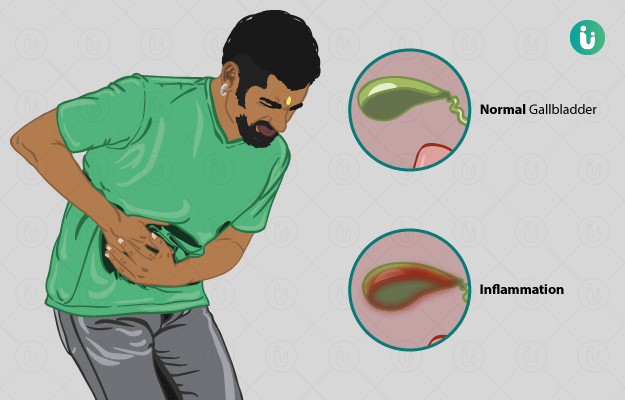What is cholecystitis?
Cholecystitis is an inflammation of the gall bladder. It is typically caused due to gall stones in any of the following tubes of the gall bladder- cystic duct, common bile duct or gall-bladder. It mainly affects women more than men. The incidence of women having gall-stones before the age of 40 is higher compared to men. The prevalence in India is found to be more in the North compared to the South. In the United States, gallstones are reported in about 1 million people every year and occur in 10-15% of the adult population.
What are its main signs and symptoms?
Some individuals may not show any symptoms except for slight tenderness in the abdominal region. Major symptoms seen include:
- Sudden or severe pain in the right upper region of the abdomen
- Nausea
- Vomiting
- Low-grade fever
- Yellow discolouration of the eyes
- Tea-coloured urine
- Light-coloured faeces
What are its main causes?
The cause can be subdivided into calculous and acalculous cholecystitis.
- Calculous cholecystitis:
- Most common and mild type of cholecystitis.
- Seen in 95% of the cases.
- Due to blocks in the main cystic duct.
- Either blocked by gall stones or biliary sludge.
- Acalculous cholecystitis:
- Rare and more severe form of acute cholecystitis.
- Develops as a result of some chronic illness, infection or injury that damages gallbladder.
- Can be associated with unintentional damage during surgery, injuries, burns, blood poisoning, sepsis and undernourished states
How is it diagnosed and treated?
Patients may appear normal on physical examination. Sometimes tenderness may be felt in the gall bladder may be felt and may be tender, indicating an acute condition. Murphy’s sign may be positive on examination.
- Blood tests: To check for any infections or complications.
- Radiological tests:
- Ultrasonography of the abdomen
- Computed Tomography (CT) scan
- Magnetic resonance cholangiopancreatography (MRCP)
- Endoscopic retrograde cholangiopancreatography (ERCP)
Treatments methods include:
- Initial therapy: Fasting to clear out the gallbladder and, intravenous fluids to maintain hydration level.
- Medical therapy: It is usually given for symptomatic gallstones. These agents dissolve bile stones and prevent further obstruction.
- Surgical therapy: Laparoscopic cholecystectomy is the preferred method to remove the gall bladder along with the stones to prevent recurrence of the condition.
Non-surgical methods include:
- Extracorporeal shock wave lithotripsy: High-energy sound waves are used to break the stones.
- Percutaneous therapy
- Endoscopic gallbladder stenting
Lifestyle modifications:
- Avoid the following foods to reduce symptoms.
- Cholesterol-rich foods
- Refined sugar
- Beans
- Onions or bell peppers
- Caffeine
- Include foods rich in fibre such as nuts, fruits and vegetables and healthy fats like fish and olive oil.
Adopting a healthy lifestyle helps in reducing the risk of cholecystitis.

 Doctors for Cholecystitis
Doctors for Cholecystitis  OTC Medicines for Cholecystitis
OTC Medicines for Cholecystitis



















